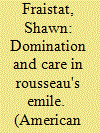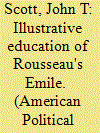| Srl | Item |
| 1 |
ID:
149686


|
|
|
|
|
| Summary/Abstract |
Domination, understood as the abusive or capricious employment of power over others for the sake of one's own ends, is among the gravest threats to human freedom. Solving the problem of domination is a crucial normative challenge, and this article identifies in the work of Jean-Jacques Rousseau a promising and overlooked avenue for addressing it. I propose an interpretation of Rousseau's Emile in which preventing domination requires moral education in the practice and value of care. This interpretation gives Rousseau new relevance as a theorist of domination. In connecting non-dominative to educative care, Rousseau's approach has the potential to forge new connections between neo-republican theories of domination and feminist care ethics, even suggesting new routes by which public policy might foster a non-dominative society.
|
|
|
|
|
|
|
|
|
|
|
|
|
|
|
|
| 2 |
ID:
133943


|
|
|
|
|
| Publication |
2014.
|
| Summary/Abstract |
Rousseau's mission as an author was to make his readers see what he saw in his philosophical "illumination," yet his task is a paradoxical one, for he must persuade his readers that they are deceived by what they see before their own eyes and must learn to see anew. In order to transform the perspective of his reader, Rousseau throughout his works uses visual imagery and rhetorical devices invoking vision that represents both the correct view of human nature and virtue and the obstacles to learning to see ourselves properly. As a former engraver's apprentice, he was particularly interested in educating his reader through actual images such as frontispieces or illustrations. The aim of this article is to offer an interpretation of the engravings that illustrate Emile, or On Education, in order to investigate how Rousseau educates his reader through challenging the reader's preconceptions concerning human nature and replacing traditional exemplars of human nature and virtue with a new exemplar seen in his imaginary pupil.
|
|
|
|
|
|
|
|
|
|
|
|
|
|
|
|